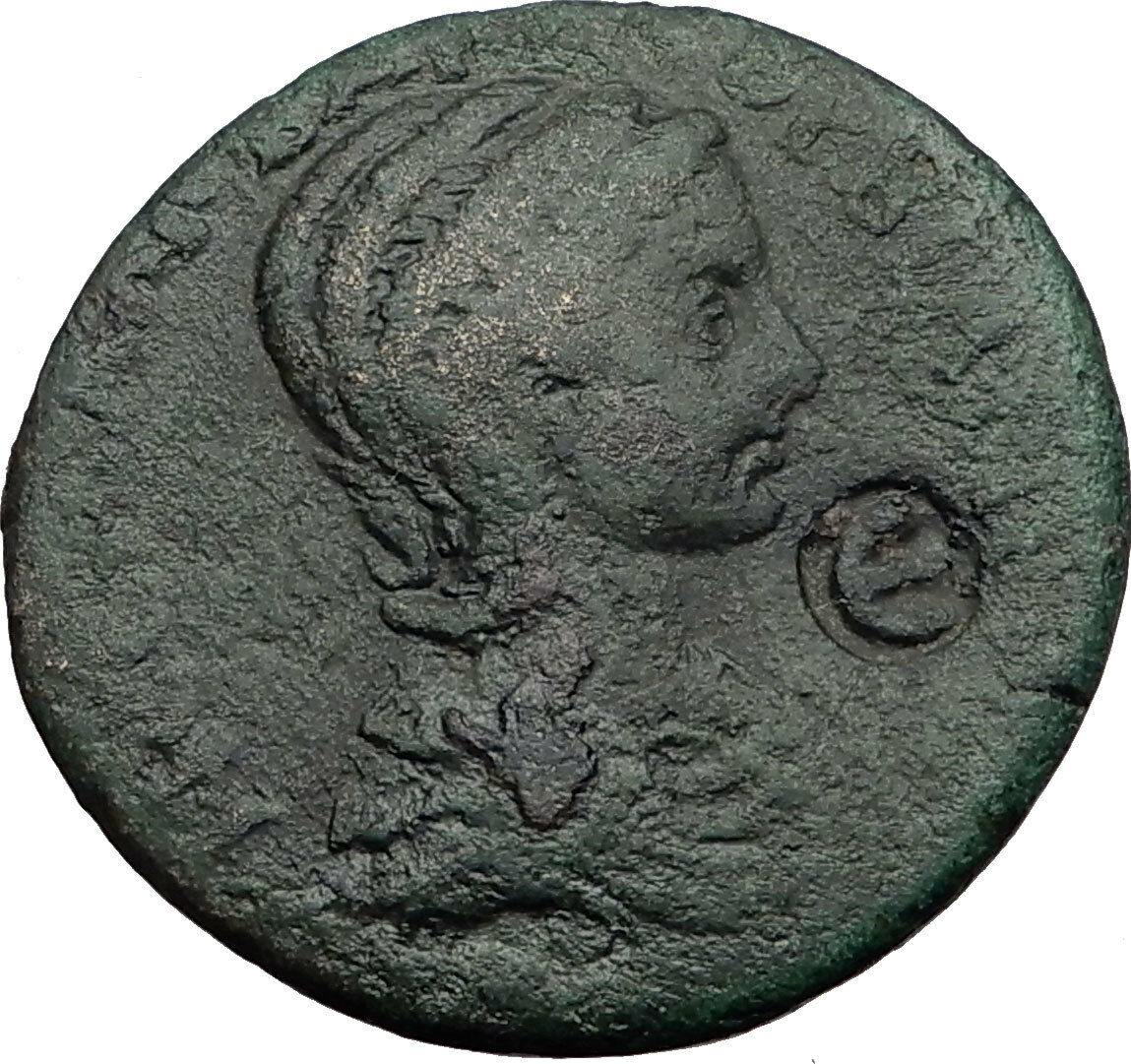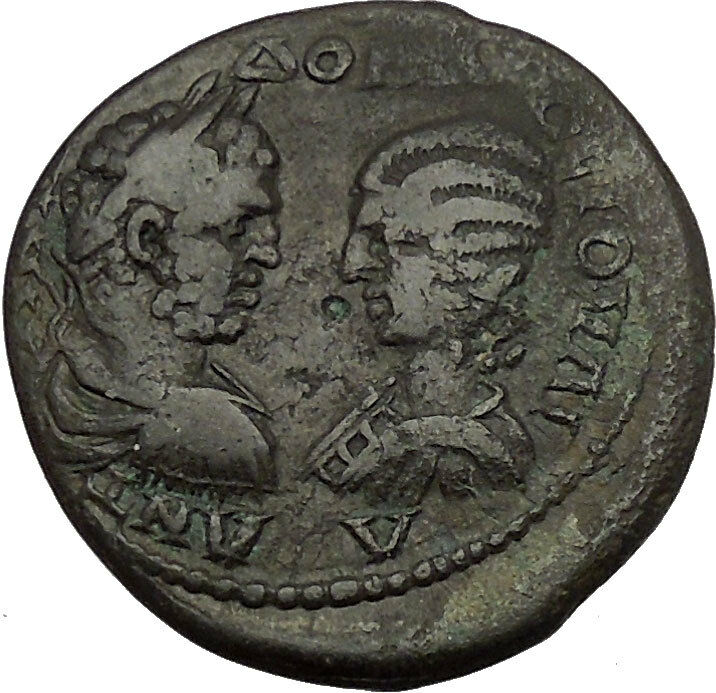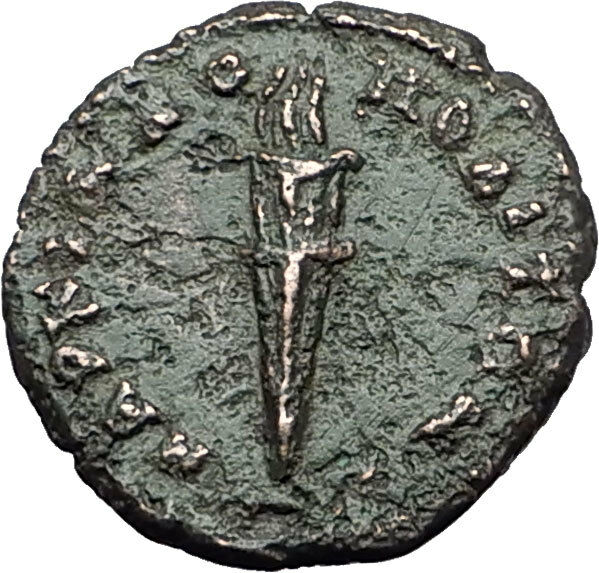|
Otacilia Severa – Roman Empress: 244-249 A.D. wife of Philip I ‘the Arab’
Bronze 22mm (4.49 grams) of Deultum in Thrace
Reference: SNG Bulgaria I, 1996. SNRIS Deultum 15
MARCIA OTACIL SEVHRA AVG, Diademed draped bust right.
COL FL PAC DEVLT, Serapis standing facing, head left, raising right hand and holding transverse scepter.
You are bidding on the exact item pictured, provided with a Certificate of Authenticity and Lifetime Guarantee of Authenticity.
 Serapis (Latin spelling, or Sarapis in Greek) was a syncretic Hellenistic-Egyptian god in Antiquity. His most renowned temple was the Serapeum of Alexandria. Under Ptolemy Soter, efforts were made to integrate Egyptian religion with that of their Hellenic rulers. Ptolemy’s policy was to find a deity that should win the reverence alike of both groups, despite the curses of the Egyptian priests against the gods of the previous foreign rulers (i.e Set who was lauded by the Hyksos). Alexander the Great had attempted to use Amun for this purpose, but he was more prominent in Upper Egypt, and not as popular with those in Lower Egypt, where the Greeks had stronger influence. The Greeks had little respect for animal-headed figures, and so a Greek-style anthromorphic statue was chosen as the idol, and proclaimed as the equivalent of the highly popular Apis. It was named Aser-hapi (i.e. Osiris-Apis), which became Serapis, and was said to be Osiris in full, rather than just his Ka (life force). Serapis (Latin spelling, or Sarapis in Greek) was a syncretic Hellenistic-Egyptian god in Antiquity. His most renowned temple was the Serapeum of Alexandria. Under Ptolemy Soter, efforts were made to integrate Egyptian religion with that of their Hellenic rulers. Ptolemy’s policy was to find a deity that should win the reverence alike of both groups, despite the curses of the Egyptian priests against the gods of the previous foreign rulers (i.e Set who was lauded by the Hyksos). Alexander the Great had attempted to use Amun for this purpose, but he was more prominent in Upper Egypt, and not as popular with those in Lower Egypt, where the Greeks had stronger influence. The Greeks had little respect for animal-headed figures, and so a Greek-style anthromorphic statue was chosen as the idol, and proclaimed as the equivalent of the highly popular Apis. It was named Aser-hapi (i.e. Osiris-Apis), which became Serapis, and was said to be Osiris in full, rather than just his Ka (life force).
History
The earliest mention of a Serapis is in the disputed death scene of Alexander (323 BC). Here, Serapis has a temple at Babylon, and is of such importance that he alone is named as being consulted on behalf of the dying king. His presence in Babylon would radically alter perceptions of the mythologies of this era, though fortunately it has been discovered that the unconnected Babylonian god Ea (Enki) was titled Serapsi, meaning king of the deep, and it is possibly this Serapsi which is referred to in the diaries. The significance of this Serapsi in the Hellenic psyche, due to its involvement in Alexander’s death, may have also contributed to the choice of Osiris-Apis as the chief Ptolemaic god.
According to Plutarch, Ptolemy stole the cult statue from Sinope, having been instructed in a dream by the unknown god, to bring the statue to Alexandria, where the statue was pronounced to be Serapis by two religious experts. One of the experts was of the Eumolpidae, the ancient family from whose members the hierophant of the Eleusinian Mysteries had been chosen since before history, and the other was the scholarly Egyptian priest Manetho, which gave weight to the judgement both for the Egyptians and the Greeks.
Plutarch may not however be correct, as some Egyptologists allege that the Sinope in the tale is really the hill of Sinopeion, a name given to the site of the already existing Serapeum at Memphis. Also, according to Tacitus, Serapis (i.e. Apis explicitly identified as Osiris in full) had been the god of the village of Rhakotis, before it suddenly expanded into the great capital of Alexandria.
The statue suitably depicted a figure resembling Hades or Pluto, both being kings of the Greek underworld, and was shown enthroned with the modius, a basket/grain-measure, on his head, since it was a Greek symbol for the land of the dead. He also held a sceptre in his hand indicating his rulership, with Cerberus, gatekeeper of the underworld, resting at his feet, and it also had what appeared to be a serpent at its base, fitting the Egyptian symbol of rulership, the uraeus.
With his (i.e. Osiris’) wife Isis, and their son (at this point in history) Horus (in the form of Harpocrates), Serapis won an important place in the Greek world, reaching Ancient Rome, with Anubis being identified as Cerberus. In Rome, Serapis was worshiped in the Iseum Campense, the sanctuary of the goddess Isis located in the Campus Martius and built during the Second Triumvirate. The Roman cults of Isis and Serapis gained in popularity late in the first century thanks to the god’s role in the miracles that the imperial usurper Vespasian experienced in the city of Alexandria, where he stayed prior to his return to Rome as emperor in 70 AD. From the Flavian Dynasty on, Serapis sometimes appeared on imperial coinage with the reigning emperor. The great cult survived until 385, when a Christian mob destroyed the Serapeum of Alexandria, and subsequently the cult was forbidden by the Theodosian decree.
The early Alexandrian Christian community appears to have been rather syncretic in their worship of Serapis and Jesus and would prostrate themselves without distinction between the two. A letter inserted in the Augustan History, ascribed to the Emperor Hadrian, refers to the worship of Serapis by residents of Egypt who described themselves as Christians, and Christian worship by those claiming to worship Serapis, suggesting a great confusion of the cults and practices:
The land of Egypt, the praises of which you have been recounting to me, my dear Servianus, I have found to be wholly light-minded, unstable, and blown about by every breath of rumour. There those who worship Serapis are, in fact, Christians, and those who call themselves bishops of Christ are, in fact, devotees of Serapis. There is no chief of the Jewish synagogue, no Samaritan, no Christian presbyter, who is not an astrologer, a soothsayer, or an anointer. Even the Patriarch himself, when he comes to Egypt, is forced by some to worship Serapis, by others to worship Christ.
Debelt is a village in Sredets municipality in Burgas Province in southeastern Bulgaria, about 25 kilometers from Burgas. It has a population of 1,574 and an altitude of 46 meters. The village was founded around the 2nd century by the Roman emperor Vespasian. Then called Deultum, it was the only Roman colony on Bulgarian land in the Flavian dynasty. During the Byzantine era it was known as Develtos (Greek: Δεβελτός).
Otacilia Severa – Roman Empress: 244-249 A.D.
| Wife of Philip I ‘the Arab’ | Mother of Philip II | Daughter in law (possibly posthumously) of Julius Marinus |
 Marcia Otacilia Severa or Otacilia Severa was the Empress of Rome and wife of Emperor Marcus Julius Philippus or Philip the Arab who reigned over the Roman Empire from 244 to 249. Marcia Otacilia Severa or Otacilia Severa was the Empress of Rome and wife of Emperor Marcus Julius Philippus or Philip the Arab who reigned over the Roman Empire from 244 to 249.
Severa was a member of the ancient gens Otacilius who were people of consular and senatorial rank. Severa’s father was Otacilius Severus or Severianus, who served as Roman Governor of Macedonia and Moesia, while her mother was a member of gens Marcius or was related to the gens. According to sources she had a brother called Severianus, who served as Roman Governor of Lower Moesia between 246-247.
Little is known on her life before marrying Philip. In 234, Severa married Philip who served in the Praetorian Guard under Emperor Alexander Severus. Severa had two children with Philip: a son named Marcus Julius Philippus Severus or Philippus II (born in 238) and – according to numismatic evidence – a daughter called Julia Severa or Severina, who is never mentioned by the ancient Roman sources.
In February 244, Gordian III was killed in Mesopotamia. There is a possibility that Severa was involved in a conspiracy to murder Gordian. Philip became the new emperor who gave his young predecessor a proper funeral and his ashes were returned to Rome for burial.
Philip gave Severa the honorific title of Augusta. Their son was made heir of the purple. Sometimes Severa and Philip are considered as the first Christian imperial couple, because during their reign the persecutions of Christians had ceased and the couple had become tolerant towards the faith of the Christians. Through her intervention, she saved Bishop and Saint Babylas of Antioch from persecution.
In August 249, Philip had died in battle in Verona and Decius (emperor) became the new emperor. Severa was in Rome that time. When the news of Philip’s death had reached Rome, Severa’s son was murdered by the Praetorian Guard. The child died in her arms. Severa survived her husband and son and lived later in obscurity. Her later life is unknown.
|





 Serapis (Latin spelling, or Sarapis in Greek) was a syncretic Hellenistic-Egyptian god in Antiquity. His most renowned temple was the Serapeum of Alexandria. Under Ptolemy Soter, efforts were made to integrate Egyptian religion with that of their Hellenic rulers. Ptolemy’s policy was to find a deity that should win the reverence alike of both groups, despite the curses of the Egyptian priests against the gods of the previous foreign rulers (i.e Set who was lauded by the Hyksos). Alexander the Great had attempted to use Amun for this purpose, but he was more prominent in Upper Egypt, and not as popular with those in Lower Egypt, where the Greeks had stronger influence. The Greeks had little respect for animal-headed figures, and so a Greek-style anthromorphic statue was chosen as the idol, and proclaimed as the equivalent of the highly popular Apis. It was named Aser-hapi (i.e. Osiris-Apis), which became Serapis, and was said to be Osiris in full, rather than just his Ka (life force).
Serapis (Latin spelling, or Sarapis in Greek) was a syncretic Hellenistic-Egyptian god in Antiquity. His most renowned temple was the Serapeum of Alexandria. Under Ptolemy Soter, efforts were made to integrate Egyptian religion with that of their Hellenic rulers. Ptolemy’s policy was to find a deity that should win the reverence alike of both groups, despite the curses of the Egyptian priests against the gods of the previous foreign rulers (i.e Set who was lauded by the Hyksos). Alexander the Great had attempted to use Amun for this purpose, but he was more prominent in Upper Egypt, and not as popular with those in Lower Egypt, where the Greeks had stronger influence. The Greeks had little respect for animal-headed figures, and so a Greek-style anthromorphic statue was chosen as the idol, and proclaimed as the equivalent of the highly popular Apis. It was named Aser-hapi (i.e. Osiris-Apis), which became Serapis, and was said to be Osiris in full, rather than just his Ka (life force).  Marcia Otacilia Severa or Otacilia Severa was the Empress of Rome and wife of Emperor Marcus Julius Philippus or Philip the Arab who reigned over the Roman Empire from 244 to 249.
Marcia Otacilia Severa or Otacilia Severa was the Empress of Rome and wife of Emperor Marcus Julius Philippus or Philip the Arab who reigned over the Roman Empire from 244 to 249.




